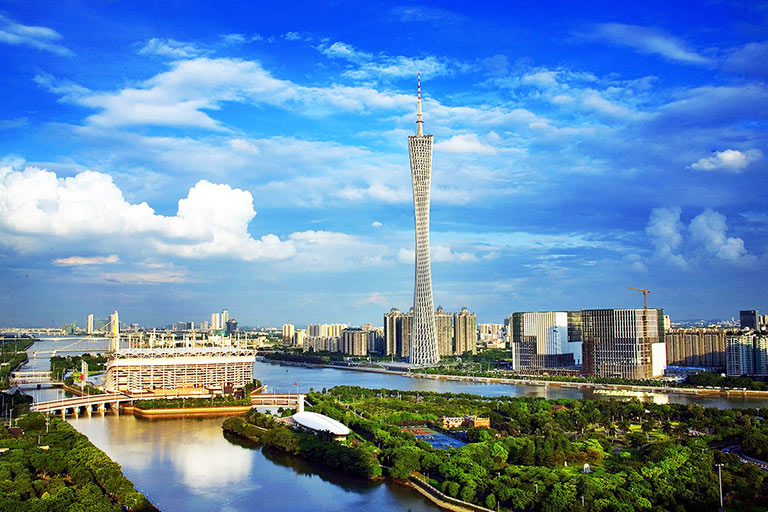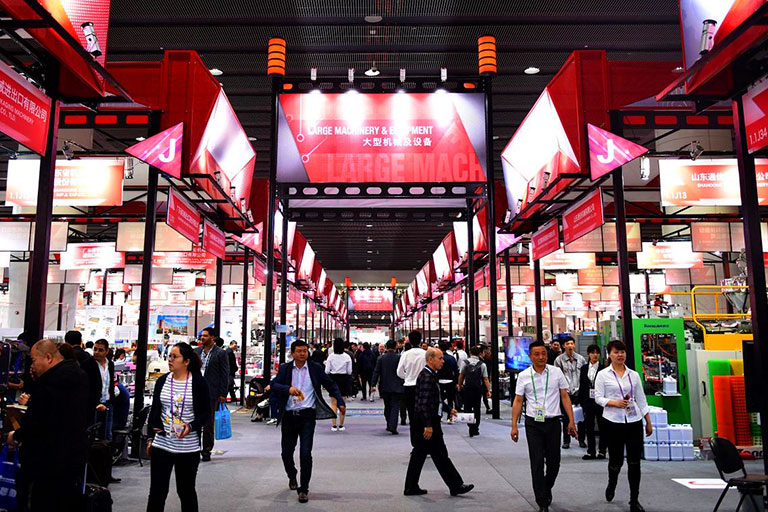Why Is It Worth a Visit to Temple of the Six Banyan Trees?
The Temple of the Six Banyan Trees or Liurong Temple (六榕寺) carries about 1500 years. It is one of the birthplaces of Chinese (Zen) Chan Buddhism. and has the Hall of Huineng (one of the founders of Chinese Chan Buddhism). It is in the list of ”the Four Buddhist Sites of Guangzhou” with Guangxiao Temple, Hualin Temple and Hoi Tong Monastery. The Flower Pagoda in the Liurong Temple, one of the oldest landmarks in Guangzhou, also has a same fame as the temple. It is an octangular pagoda with 57.6m high which is the tallest pagoda in Guangzhou city. There is an old saying, “The Guangxiao Temple is famous for its trees, and the Jinghui Temple (Liurong Temple) is distinguished for its pagoda”. In 1983, Temple of the Six Banyan Trees was recognized as one of the most important Buddhist temples of Han Chinese. In 1997, it was listed in the record of “Top Ten Tourist Attractions in Guangzhou”.
Although it is near the center of Guangzhou, Liurong Temple is escaping far from the hustle, bustle and blare all around, this place is amazingly quiet. Monks here in the temple is quite friendly and warm. Once strolling in the temple, people can feel spiritual peace. During every special Chinese festival, the temple sees a continuous line of Buddhists who come for praying. Anyone could pay to have a private blessing with one of the monks in the temple, or throw a coin in the can in the courtyard for good luck.
 Flower Pagoda
Flower Pagoda
Best Guangzhou City Tours with Liurong Temple
>>3 Days Guangzhou Short Stay Tour
Why Is It Called Temple of the ‘Six Banyan Trees’?
It has subsequently been rebuilt several times, and its name has also changed many times from “Baoyan Temple” to “Temple of the Six Banyan Trees”. In AD 1100, a great Chinese poet Sushi (苏轼) happened to be in Guangzhou. Out of admiration for the temple, he went to the temple. Once arriving at there, he was attracted by the 6 old and strong banyan trees, so he wrote down two Chinese characters - ”Liurong”. It was well-known that Sushi is both an outstanding poet and an excellent calligrapher. The monks in the temple carved the “Liurong” on the stone wall, and this temple was thus called “The Temple of Six Banyan Trees (Liurong Temple)”. The characters written by Su are also the represent of Su’s Calligraphy. When the temple was rebuilt in 1982, the two characters was engraved on tablet and hung above the gate of the temple.
The current banyan trees, though not the original trees, are over 170 years. There is a “Pavilion of Replanting Banyan Trees (补榕亭)” built in 1919, in which sits a statue of Bodhisattva. Nowadays, you could see the characters ”Liurong” written by Sushi above the gate.
 Temple of the Six Banyan Trees
Temple of the Six Banyan Trees
Layout About Temple of the Six Banyan Trees
Covering 8,500 square meters, Temple of the Six Banyan Trees consists of over 13 buildings. The temple has two vertical building-axis, with the octangular Flower Pagoda at the center. The gate and the Main Shrine Hall (大雄宝殿) lay on the east-to-west axis, and the Scripture Library (藏经阁) and the Avalokitesvara Hall lay on the north-to-east axis. On the east of the pagoda are gate, Maitreya Hall, Hall of Heavenly Kings and Hall of General Weituo. On the south of the Main Shrine Hall are Banyan Garden, Hall of Huineng, Pavilion of Replanting Banyan Trees and so on.
On the west of the pagoda is the Main Shrine Hall, in which sit 3 big Buddha statues, each one of which is 6m high and 10 ton. There is also a wooden stupa inside the hall. In 1985, an abbot, the brother of Thai emperor, gave the stupa as a gift to Liurong Temple. The stupa with delicate wood carving is about 60cm high. The abbot and monks of the Liurong Temple chanted sutra together and prayed for world peace and happiness of people.
On the north of the Main Shrine Hall is the Hall of Friendship (友谊佛堂). In the hall sits a statue of Shakyamuni, which is given by the education Ministry of Thai. The statue is the proof of the friendship between China and Thailand, and the friendly exchanges of Buddhism between two peoples.
Three Highlights About Temple of the Six Banyan Trees:
Temple of the Six Banyan Trees is one of the Buddhist sites in Guangzhou, but it also features with 3 highlights - architectural art, lively Buddha statues and Flower Pagoda - that attract people who are not Buddhists.
Come to Enjoy Architectural Art
Temple of the Six Banyan Trees is centered with the Flower Pagoda, which maintains the architectural style in early India. It is a combination of the architectural style in ancient India and ancient China. This kind of architectural style is rarely to see now in Chinese temple.
There are also various wood carvings, stone engravings and iron casting, which vividly shows the architectural style in Qing Dynasty (1644 - 1912). When you come into the temple, you must have a feeling of transferring to the ancient China.
 Architectural Art
Architectural Art
Come to View Lively Buddha Statues
As a Buddhist temple, Liurong Temple is certainly full of various Buddha statues. Here you could learn about Buddhism culture in Chinese Han area, through which you will know a little Chinese culture.
Once entering the gate of the temple, you will see the "Laughing Buddha"- iconic Chinese portrayal of Maitreya - the Buddha of the Future. The image of Maitreya is a person with a full figure, a benign countenance and a smiling face. In Chinese legend, he was a poor but happy traveling monk named Budai who was one of the several "uncommitted saints" that became incorporated into the Zen. Thus he is also popular among Chinese people.
Near the “Laughing Buddha” are statues of Four Heavenly Kings in Chinese han Buddhism. They separately hold a sword, a Pipa (stringed instrument), an umbrella and a snake. In Chinese han Buddhism, They four separately represent the wind (Chinese: Feng), harmony (Chinese: Tiao), rain (Chinese: Yu) and smooth going (Chinese: Shun). Totally, the four kings represent the saying of (Chinese: feng tiao yu shun) “good weather for the crops”.
Behind the Hall of Heavenly Kings is General Weituo, a much more serious looking countenance. He is regarded as the protector of Buddhists and his image is a young general with weapons.
 Avalokitesvara
Avalokitesvara
Come to Appreciate Flower Pagoda
The flower pagoda with 57.6m high is one of the oldest landmark of Guangzhou. It was originally built in AD537, and carries almost 1500 years. However, it looks very nice because of the conservation and renovation. You can see the overall view of Guangzhou from the pagoda, which would be a cool experience. Climbing up the pagoda is helpful to your health.
You will firstly see the pagoda even when you don’t see the temple. At first, it was a quadrilateral wooden pagoda with Buddhist relics. Later it was rebuilt as an octangular brick-wood made pagoda. When you looking from the outdoors, the pagoda has 9 floors. However, you will not know that 8 floors are hidden inside the pagoda. So amazing, isn’t it?
Every layer of overhanging eaves is like a blooming bud, and the tower spire is like stamen. Meanwhile, the entire pagoda is like a huge style up towards the sky. In addition, the color of the pagoda’s body is red and white. Therefore, the pagoda is usually named as Flower Pagoda. There are intricate wooden carvings under the eaves and a beautiful bronze pillar depicting 1,000 Buddhist figures on the top floor.
(Note: Tourists recently are not allowed to go into the pagoda. The time for opening is not sure now, we will keep in update.)
 Flower Pagoda
Flower Pagoda
Where Is Temple of the Six Banyan Trees
Temple of the Six Banyan Trees is located at No.87, Liu Rong Road, Zhong Shan 6 Road, Yuexiu District, Guangzhou City, Guangdong Province, China (广东省广州市越秀区中山六路六榕路87号). It is in the downtown area. It will be very convenient if you take taxi, bus or subway to there.
It is about 32km from Guangzhou Baiyun International Airport, you can take a taxi which will spend about 40minutes.
It is 800m from the People’s Park (the original center of the city).
Or you can travel with us to save all the troubles. We will provide you with cosy vehicles, professional guides and drivers. What’s more, all the pick-up and drop-off services in the trip are included. It is very convenient if you want to travel somewhere nearby. For more details, please feel free to contact us.
Nearby Tourist Attractions
If you want to enrich your trip, here are some attractions nearby you can choose.
- It takes about 3minutes to walk from the east gate of Guangxiao Temple.
- It is about 15km from Canton Tower, you will take aboout 30 minutes by taxi to here.
- You can walk to here from Sun Yat-sen Memorial Hall for about 20 minutes or you can take a taxi for about 5 minutes.
- It is about 1km from the Museum of the Nanyue King Mausoleum.
- It is about 2km from Yuexiu park.
- It is about 3km from Chen Clan Ancestral Hall.
If you do not know how to schedule your trip, here is a 6 Days Canton Fair & Guangzhou Highlights Tour that covers most of the attractions mentioned above for your reference.
Warm Tips
1.If you want to experience the Buddhists’ praying, you could choose to go there during Chinese festivals such as Spring Festival, Lantern Festival, Dragon Boat Festival and so on.
2.You can pay to have a private blessing with one of the monks in the temple.
3.You could throw a coin in the can in the courtyard for good luck.
4.You are not allowed to take photos of Buddha statues.
Travel with China Discovery (Top Recommended)
Perhaps you are still nervous about your journey, please feel free to contact us and we will offer you a personal tailor-made trip! We are specialized in customized trips. You will feel comfortable about our plan.
Top Attractions in & around Guangzhou
- Chen Clan Ancestral Hall
- Temple of the Six Banyan Trees
- Yuexiu Park
- Canton Tower
- Sun Yat-sen Memorial Hall
- Nanyue King Mausuleum
- Kaiping Diaulou and Villages
- All Popular Guangzhou Tours
- How to Plan a Guangzhou Tour
- How to Get to & Around Guangzhou
- From Guangzhou Airport to Downtown
- Guangzhou Maps
- Guangzhou Metro
- Flights to Guangzhou
- Things to Do in Guangzhou
- Featured Activities in Guangzhou
- Top 6 Things to Do at Night
- Canton Fair (Import & Export Fair)
- Guangzhou Weather & Seasons
- Luxury Hotels in Guangzhou
- Comfortable Hotels in Guangzhou
- Where to Stay in Guangzhou
- 10 Best Cantonese Restaurants
- Top Food to Eat in Guangzhou
- All Guangzhou Travel Guide
Other Useful Travel Articles of Guangzhou
Recommended Guangzhou Tours
Top 3 Guangzhou tours chosen by most customers to explore Guangzhou in the best way. Check the detailed itinerary, or tailor your own trip now with us.
Start planning your tailor-made holiday to China by contacting one of our specialists. Once inquired, you’ll get a response within 0.5~23.5 hours.
Customize a TripHave a question? Get answers from our travel experts or guests
- Your Question:
- Your Name:
- Your Email:
- Submit























































